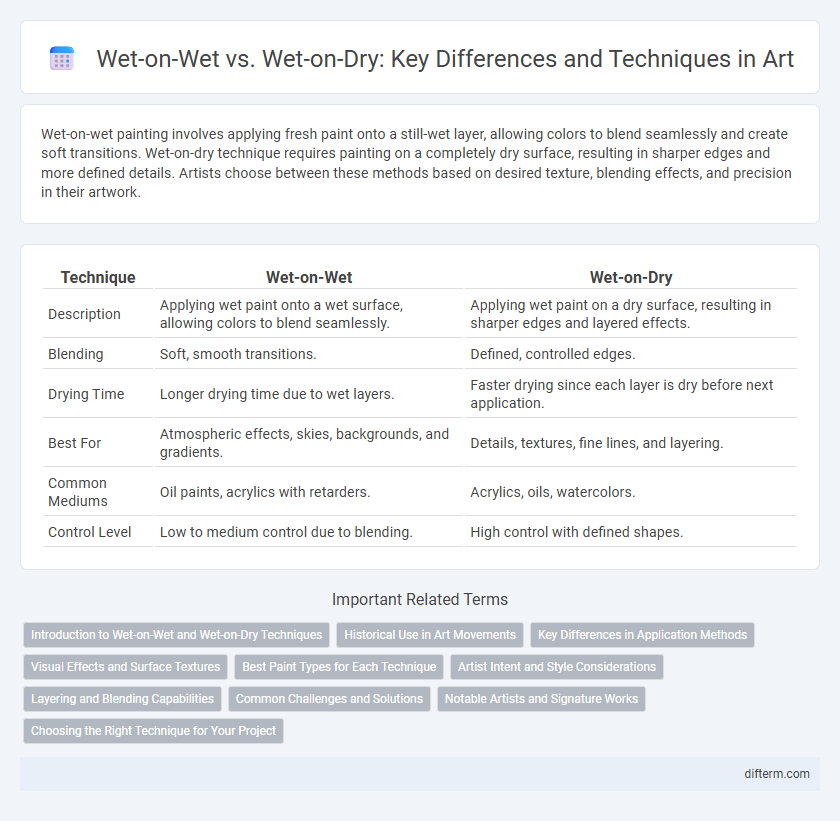Wet-on-wet painting involves applying fresh paint onto a still-wet layer, allowing colors to blend seamlessly and create soft transitions. Wet-on-dry technique requires painting on a completely dry surface, resulting in sharper edges and more defined details. Artists choose between these methods based on desired texture, blending effects, and precision in their artwork.
Table of Comparison
| Technique | Wet-on-Wet | Wet-on-Dry |
|---|---|---|
| Description | Applying wet paint onto a wet surface, allowing colors to blend seamlessly. | Applying wet paint on a dry surface, resulting in sharper edges and layered effects. |
| Blending | Soft, smooth transitions. | Defined, controlled edges. |
| Drying Time | Longer drying time due to wet layers. | Faster drying since each layer is dry before next application. |
| Best For | Atmospheric effects, skies, backgrounds, and gradients. | Details, textures, fine lines, and layering. |
| Common Mediums | Oil paints, acrylics with retarders. | Acrylics, oils, watercolors. |
| Control Level | Low to medium control due to blending. | High control with defined shapes. |
Introduction to Wet-on-Wet and Wet-on-Dry Techniques
Wet-on-wet and wet-on-dry are two fundamental painting techniques used in oil and acrylic art. Wet-on-wet involves applying fresh paint onto a still-wet layer, allowing seamless blending and soft transitions ideal for landscapes and portraits. Wet-on-dry requires painting over dried layers, enabling sharp edges, detailed textures, and controlled layering for intricate compositions.
Historical Use in Art Movements
Wet-on-wet painting technique gained prominence during the Impressionist movement, enabling artists like Claude Monet to capture light and color with swift, expressive brushstrokes. In contrast, wet-on-dry was favored in Renaissance art, allowing painters such as Leonardo da Vinci to achieve precise details and layered textures. This distinction influenced the evolution of artistic styles by dictating how color blending and detail work were approached across different periods.
Key Differences in Application Methods
Wet-on-wet technique involves applying fresh paint onto still-wet layers, allowing colors to blend seamlessly and create soft edges ideal for dynamic, fluid effects. Wet-on-dry requires painting over completely dried layers, resulting in sharper lines and distinct color separation, which is essential for detailed work and layering. The choice between these methods impacts texture, blending, and the overall finish of the artwork.
Visual Effects and Surface Textures
Wet-on-wet painting creates smooth gradients and soft edges by blending colors directly on the canvas, producing fluid visual effects ideal for atmospheric scenes. Wet-on-dry technique allows for sharper details and distinct textures as each layer dries before applying the next, resulting in more defined surface textures and heightened contrast. Artists choose wet-on-wet for seamless transitions and wet-on-dry for controlled texture and precision in their compositions.
Best Paint Types for Each Technique
Oil paints are ideal for the wet-on-wet technique due to their slow drying time, allowing artists to blend colors seamlessly on the canvas. Acrylic paints, which dry quickly, work best for wet-on-dry methods, enabling distinct layers and sharp edges without color mixing. Watercolors can also be used wet-on-wet for soft, fluid effects and wet-on-dry for precise details, depending on the desired artistic outcome.
Artist Intent and Style Considerations
Wet-on-wet technique allows artists to blend colors seamlessly and create soft transitions, aligning with expressive and impressionistic styles that emphasize spontaneity and fluidity. Wet-on-dry offers precise control and sharp edges, supporting detailed realism and defined compositions suited for meticulous or structured artworks. Choice between these methods directly influences the artist's intent by shaping texture, mood, and visual clarity within the painting.
Layering and Blending Capabilities
Wet-on-wet technique allows artists to blend colors seamlessly on the canvas, creating smooth gradients and soft transitions ideal for impressionistic styles. Wet-on-dry method enables precise layering of paint, preserving distinct edges and textures, which is essential for detailed and structured compositions. Mastery of both techniques enhances control over depth, texture, and color dynamics in a painting.
Common Challenges and Solutions
Wet-on-wet painting often leads to color blending challenges, causing unintended muddy effects that obscure fine details. To overcome this, artists use slower-drying mediums or layering techniques to control pigment flow and maintain vibrancy. Wet-on-dry offers sharper edges but requires careful timing to prevent cracking, so applying thin layers and allowing adequate drying time ensures a smooth, stable finish.
Notable Artists and Signature Works
Notable artists such as Bob Ross popularized the wet-on-wet technique, exemplified in his signature work "The Joy of Painting," which allows for smooth blending and soft transitions. In contrast, artists like Vincent van Gogh mastered the wet-on-dry method, demonstrated in masterpieces like "Starry Night," where bold, textured brushstrokes stand out with distinct edges. These contrasting techniques have defined the unique visual styles and expressive qualities of their respective artists' works.
Choosing the Right Technique for Your Project
Wet-on-wet painting involves applying fresh paint onto a still-wet layer, allowing colors to blend seamlessly and create soft gradients ideal for landscapes and expressive works. Wet-on-dry technique requires letting the first layer dry completely before adding new paint, providing sharper details and precise edges perfect for portraits and detailed illustrations. Selecting the right method depends on your project's desired texture, blending complexity, and overall visual effect.
Wet-on-wet vs Wet-on-dry Infographic

 difterm.com
difterm.com